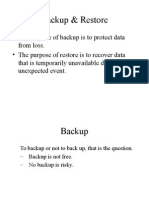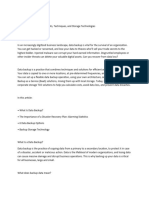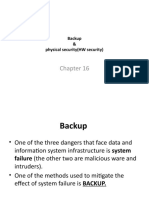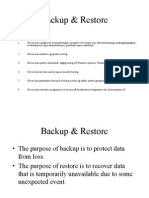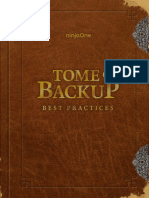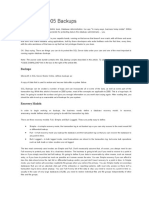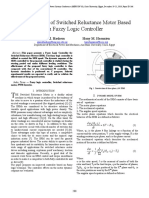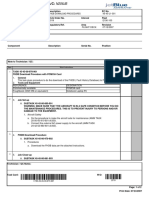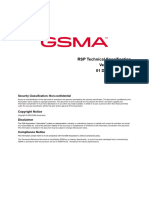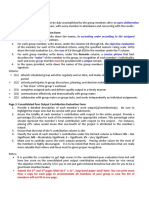Backup Database Week 8
Uploaded by
denostaleighnicoleBackup Database Week 8
Uploaded by
denostaleighnicoleSQLShack SQL Server training Español
Newsletter
An overview of the process of SQL Server backup-and-
restore Enter your email
March 1, 2018 by Prashanth Jayaram
Subscribe
Follow us!
In a manner of speaking, planning and implementing a SQL Server backup design is an art. Backup, Restoration,
Recovery, Business Continuity Plans (BCP), and Disaster Recovery (DR) are different phases of data revolving
around the discussions involving data backup. In other words, it’s about how we ensure to retain the business
data through any sort of situation that’s thrown at us.
Backup is probably the simplest and the most familiar process in most situations. A backup is a copy of the data
derived from the production copy, stored at a location that’s different from where the production data is stored.
A backup copy is used toThis website
recover datauses cookies.
needed By continuing
to restart to usecorrectly,
an application this site and/or clicking
after certain the of
types "Accept"
failures.button you Accept
are providing
Using various tools and techniques, theconsent
data is replicated to different geographies and is made available all the
time. Some may even argue that having multiple working copies of the data somewhere else removes the need
Quest Software and its affiliates do NOT sell the Personal Data you provide to us either when you
for having backups, but in a not-so-perfect
register world,or
on our websites backups are do
when you stillbusiness
requiredwith
to make sure
us. For youinformation
more can always about our
Privacy Policy and our data protection efforts, please visit GDPR-HQ
recover from data mishaps.
Popular
CASE statement in SQL
What is a backup? SQL Convert Date functions and formats
SQL PARTITION BY Clause overview
The word backup refers to copying and archiving the data so that it may be used to restore in case of an event
SQL Server table hints – WITH (NOLOCK) best
of data loss. In general, you should back up any work or data that can’t be replaced easily. practices
What is the difference between Clustered and Non-
A database backup is a copy of data from the database, which can be used to reconstruct the data. A database Clustered Indexes in SQL Server?
backup is a process to protect the data from various disasters. Disasters cannot be completely prevented; the Multiple options to transposing rows into columns
least we can do is to ensure we have everything that’s needed to get up and running as soon as we can. How to copy tables from one database to another in
Database backup is also performed and managed to ensure that an organization complies with business and SQL Server
government regulations. For instance, for legal reasons in the US, correspondences should be saved for at least Using the SQL Coalesce function in SQL Server
seven years in the manufacturing industry. The process of backing up data is pivotal to a successful disaster Six different methods to copy tables between
recovery (DR) plan. databases in SQL Server
Different ways to SQL delete duplicate rows from a
SQL Table
Organizations target for backup, the data they feel is vulnerable to:
How to implement array-like functionality in SQL
Server
Corruption
SQL replace: How to replace ASCII special characters
Failed hardware including media failure, software failure, and OS errors
in SQL Server
Attacks on the network or other malicious actions
Working with the SQL Server command line (sqlcmd)
Manual errors or other inadvertent actions
How to implement error handling in SQL Server
Unauthorized changes
How to move SQL database files (MDF and LDF) to
and other undesirable events
another location
SQL varchar data type deep dive
All about locking in SQL Server
How often should I run my backups (frequency of How to identify slow running queries in SQL Server
backups)? SQL WHILE loop with simple examples
SQL Server Transaction Log Backup, Truncate and
Shrink Operations
The frequency to run your backups depends on how often the data changes. You may find it helpful to consider
the following points when planning your backup schedule:
Business data that changes frequently may need daily or hourly backups
Data that changes every few days could use a weekly or even monthly backup
For some data, you might want to run a backup whenever you make a change
Predefined policies and Service Level Agreements (SLAs)govern the frequency and redundancy (or replicas) of
the backup.
Backup destination
You can store backup files in one of the following locations:
1. Local storage is used if you want to save the backup on a removable storage device attached to the
computer or on a local computer drive.
2. Shared folder is used if you want to save the backup in a network shared folder
3. Tape devices are used in case robust archival is required.
4. Cloud backup
Public cloud storage: this type of storage is often used to backup the data as part of the Disaster
Recovery where users send the data over to public cloud services such as S3. The providers generally
charge based on monthly usage of storage. Some providers also charge for data transfers and access
Private cloud storage: is referred to as internal cloud storage. In this case, the data is backed up to
servers within the environment, based on pre-determined set of policies and company’s firewall
Hybrid cloud storage: is a combination of public and private cloud.
Who should tailor your backup Trending
DELETE CASCADE and UPDATE CASCADE in SQL
Server foreign key
The backup process is handled by Backup Operators. They are specific individuals given the responsibility to
configure, schedule, initiate and monitor the backup process. How to create and configure a linked server in SQL
Server Management Studio
Step by step installation of SQL Server 2017
Understanding RPO and RTO SQL Server Statistics and how to perform Update
Statistics in SQL
The RPO (Recovery-Point-Objective) and RTO (Recovery-Time-Objective) are vital parameters to consider when SQL Union overview, usage and examples
planning the backup strategy. Query optimization techniques in SQL Server: tips
and tricks
The recovery point objective, or RPO, is the point in time that data can be restored to. For instance, if the How to install SQL Server 2014 Management Studio
most recent available backup is a week old, then we’d be able to restore to what the database looked like at that When to Use SQL Temp Tables vs. Table Variables
time the backup was taken, so you will potentially lose a week’s worth of data. On the other hand, if your most INSERT INTO SELECT statement overview and
recent backup was taken five minutes ago, then we can restore to that point in time and would lose only five examples
minutes of data. So the question would be how much data is the organization willing to lose—data worth hours, SQL multiple joins for beginners with examples
minutes, seconds or nothing at all? If the plan is zero data loss, then backup alone is not the solution. We need Substring function overview
to use additional tools and techniques to achieve the desired result. Multiple methods for scheduling a SQL Server
backup automatically
The other term, recovery time objective, (or RTO) is the amount of time taken to perform the restoration. A very Setting up the dark theme in SQL Server
Management Studio
large database may take several hours or even a day to restore, which in some cases this may not be
acceptable. Typically, running a restore takes slightly longer than running a backup, so if we do a backup which Overview of the SQL ROW_NUMBER function
takes 30 minutes to run, it wouldn’t be surprising if the restore ran for longer than 30 minutes. Understanding the GUID data type in SQL Server
Database table partitioning in SQL Server
Overview of SQL Server Ports
How to import data from an Excel file to a SQL
Server database
Techniques to bulk copy, import and export in SQL
Server
SQL Server stored procedures for beginners
Summary
As a general rule, the amount of time in between backups should be no more than the amount of time you are
willing to spend redoing any lost work. For example, if spending a week recreating the lost data is too long for
you, you should back up the data at least once a week.
The additional techniques that we mentioned for zero-loss model is called High Availability in most situations.
These may be very expensive for some organizations. On the other hand, backups are more economical to run.
Therefore, because of our budget constraints, sometimes we have to live with the fact that we will lose a few
minutes of data.
The recovery point objective and recovery time objective are metrics that are usually decided by the business. Solutions
Several aspects of business are taken into consideration when coming up with these metrics. Once these
Read a SQL Server transaction log
objectives are decided, these must be clearly communicated to the stakeholders (IT and otherwise) within the
SQL Server database auditing techniques
organization.
How to recover SQL Server data from accidental
UPDATE and DELETE operations
Table of contents – SQL Server backup and restore article How to quickly search for SQL database data and
objects
series Synchronize SQL Server databases in different
remote sources
Recover SQL data from a dropped table without
Database Backup and Restore process in SQL Server – series intro backups
How to restore specific table(s) from a SQL Server
database backup
An overview of the process of SQL Server backup-and-restore
Recover deleted SQL data from transaction logs
Understanding the SQL Server Data Management Life Cycle
How to recover SQL Server data from accidental
updates without backups
Understanding SQL Server database recovery models
Automatically compare and synchronize SQL Server
Understanding SQL Server Backup Types data
Open LDF file and view LDF file content
Backup and Restore (or Recovery) strategies for SQL Server database
Quickly convert SQL code to language-specific client
Discussing Backup and Restore Automation using SQLCMD and SQL Server agent
code
How to recover a single table from a SQL Server
Understanding Database snapshots vs Database backups in SQL Server database backup
Recover data lost due to a TRUNCATE operation
SqlPackage.exe – Automate SQL Server Database Restoration using bacpac with PowerShell or Batch techniques
without backups
Smart database backup in SQL Server 2017 How to recover SQL Server data from accidental
DELETE, TRUNCATE and DROP operations
How to perform a Page Level Restore in SQL Server Reverting your SQL Server database back to a
specific point in time
Backup Linux SQL databases Using PowerShell and Windows Task Scheduler
How to create SSIS package documentation
SQL Server database backup and restore operations using the Cloud Migrate a SQL Server database to a newer version of
SQL Server
Tail-Log Backup and Restore in SQL Server
How to restore a SQL Server database backup to an
older version of SQL Server
SQL Server Database Backup and Restore reports
Database Filegroup(s) and Piecemeal restores in SQL Server
In-Memory Optimized database backup and restore in SQL Server
Understanding Backup and Restore operations in SQL Server Docker Containers
Backup and Restore operations with SQL Server 2017 on Docker containers using Azure Data Studio
Interview questions on SQL Server database backups, restores and recovery – Part I
Interview questions on SQL Server database backups, restores and recovery – Part II
Interview questions on SQL Server database backups, restores and recovery – Part III
Interview questions on SQL Server database backups, restores and recovery – Part IV
References
Backup Overview (SQL Server)
Restore and Recovery Overview (SQL Server)
Overview of Restore Scenarios
See more
For High-speed SQL Server backup, compression and restore see Quest LiteSpeed, an enterprise tool to
schedule, automate and backup SQL databases
LiteSpeed for SQL Server provides high-speed backup, compression and res…
res… Categories and tips
► Auditing and compliance (43)
Azure (24)
Azure Data Studio (22)
Backup and restore (84)
► Business Intelligence (385)
Data science (17)
► Database design (190)
► Database development (295)
DBAtools (16)
DevOps (21)
DevSecOps (2)
Documentation (17)
ETL (49)
► Features (182)
Importing, exporting (40)
Installation, setup and configuration (78)
Jobs (23)
► Languages and coding (526)
Lists (14)
Machine learning (6)
Maintenance (74)
Migration (34)
Prashanth Jayaram ► Performance tuning (628)
I’m a Database technologist having 11+ years of rich, hands-on experience on Database ► Professional development (35)
technologies. I am Microsoft Certified Professional and backed with a Degree in Master of
Recovery (27)
Computer Application.
Security (77)
My specialty lies in designing & implementing High availability solutions and cross-platform DB Server management (10)
Migration. The technologies currently working on are SQL Server, PowerShell, Oracle and
MongoDB. SQL Azure (133)
SQL Server Management Studio (SSMS) (74)
View all posts by Prashanth Jayaram
► SQL Server versions (141)
SSIS (1)
► Technologies (144)
Related Posts: Uncategorized (2)
1. Database Backup and Restore process in SQL Server – series intro Utilities (12)
2. Backup and Restore (or Recovery) strategies for SQL Server database
3. Tail-Log Backup and Restore in SQL Server
Helpers and best practices
4. SQL Server Database Backup and Restore operations using the Cloud
BI performance counters
5. Understanding Backup and Restore operations in SQL Server Docker Containers
SQL code smells rules
Backup and restore SQL Server wait types
11,974 Views
ALSO ON SQL SHACK
SSIS Hadoop Lever T-SQL for Table-Valued How to deploy SSAS
Connection … Pinpoint Control of … Parameters in SQL … cubes
a month ago • 1 comment 18 days ago • 1 comment 2 months ago • 1 comment 2 months ago • 1 comment
In this article, we will give a This article spotlights a This article is discussing the This article explains how to
brief introduction of Hadoop clean, efficient, pinpoint T- table-valued parameters deploy SSAS Cubes using
and how it is integrated … SQL stored procedure … usage details and it also … different methods available
2 Comments SQL Shack 🔒 Disqus' Privacy Policy
1 Login
Recommend 11 t Tweet f Share Sort by Best
Join the discussion…
LOG IN WITH
OR SIGN UP WITH DISQUS ?
Name
John • 2 years ago
Thanks. Is there any way to do it automatically, using any third-party tool?
3△ ▽ • Reply • Share ›
Prashanth Jayaram > John • 2 years ago
Thanks for the comment, John!. Answer to your question is "Yes". It can be done automatically using
third-party tools. Even, third-party tools in-house many in-built features to customize the backup/restore
and Recovery process.
You can refer the TOC at the bottom of this article.
Let me know if you've any specific question so that I could give more explanation.
Best Regards,
Prashanth
3△ ▽ • Reply • Share ›
✉ Subscribe d Add Disqus to your siteAdd DisqusAdd ⚠ Do Not Sell My Data
© 2020 Quest Software Inc. ALL RIGHTS RESERVED. | GDPR | Terms of Use | Privacy
You might also like
- DBMS Unit 7 Database Backup Recovery and SecurityNo ratings yetDBMS Unit 7 Database Backup Recovery and Security11 pages
- Buffalo Tech Back Up and Restore White PaperNo ratings yetBuffalo Tech Back Up and Restore White Paper5 pages
- Performing Periodic Backup Level II Unit No. 2No ratings yetPerforming Periodic Backup Level II Unit No. 220 pages
- B-Your Backup Is Not An Archive WP 21075780-1.en-UsNo ratings yetB-Your Backup Is Not An Archive WP 21075780-1.en-Us12 pages
- KPC-OF-ALL-045 - Database Backup and RecoveryNo ratings yetKPC-OF-ALL-045 - Database Backup and Recovery93 pages
- AutomatingSQLServerBackups Nowinski 04172019No ratings yetAutomatingSQLServerBackups Nowinski 0417201951 pages
- Week 9 - Chapter 8: - Methods To Backup Databases - Types of Data To Be Backed Up - Recovery Models - Recovery MethodsNo ratings yetWeek 9 - Chapter 8: - Methods To Backup Databases - Types of Data To Be Backed Up - Recovery Models - Recovery Methods20 pages
- Management & Administration: Backup & RestoreNo ratings yetManagement & Administration: Backup & Restore8 pages
- Whitepaper - SQL Server Database Backup and Restore PlanningNo ratings yetWhitepaper - SQL Server Database Backup and Restore Planning14 pages
- Oracle 9i - User-Managed Backup and Recovery GuideNo ratings yetOracle 9i - User-Managed Backup and Recovery Guide172 pages
- Speed Control of Switched Reluctance Motor Based On Fuzzy Logic ControllerNo ratings yetSpeed Control of Switched Reluctance Motor Based On Fuzzy Logic Controller5 pages
- Build Your First AI Business in 6 Hours (Ultimate Beginner Guide)No ratings yetBuild Your First AI Business in 6 Hours (Ultimate Beginner Guide)10 pages
- A Guide To DEAP Version 2.1: A Data Envelopment Analysis (Computer) ProgramNo ratings yetA Guide To DEAP Version 2.1: A Data Envelopment Analysis (Computer) Program49 pages
- Newest Repair Tools and Spare Parts-Tiff2024No ratings yetNewest Repair Tools and Spare Parts-Tiff202442 pages
- Cabling Guide For Console and AUX Ports - CiscoNo ratings yetCabling Guide For Console and AUX Ports - Cisco12 pages
- Packet Tracer - Access Control List Demonstration: ObjectivesNo ratings yetPacket Tracer - Access Control List Demonstration: Objectives3 pages
- Auto Chemistry Analyzer User Manual en B2 HETO AU200 and AU150No ratings yetAuto Chemistry Analyzer User Manual en B2 HETO AU200 and AU150225 pages
- Modernizing Legacy C++ Code - Gregory and McNellis - CppCon 2014No ratings yetModernizing Legacy C++ Code - Gregory and McNellis - CppCon 201481 pages
- Using HP Smart Update Manager With HP Integrity Servers: Capabilities, Best Practices, and TroubleshootingNo ratings yetUsing HP Smart Update Manager With HP Integrity Servers: Capabilities, Best Practices, and Troubleshooting34 pages
















